Introduction
Following the recent murder and break in at Frank Aborio’s apartment, the NSW Police department asked Deakin Forensic Unit to help determine the real culprits in the murder case by determining the likely sources of the blood evidence, footprints and toolmark impressions.
A criminal suspect may leave shoe prints at a crime scene. The shoe prints could take the form of “bloody prints or even tread marks on paper” (Tilstone 2006, p.260). It is essential to take photographs of shoeprints for evidence purposes and keep them for future reference. A high quality picture is necessary to capture all the print features. It is imperative to carry surfaces containing shoeprints to the laboratory whenever possible. This is only feasible for small pieces of evidence such as tiles or paper. For large surfaces, we obtain prints using methods similar to fingerprinting. Collected shoe prints are compared with shoe evidences. When shoe evidence are unavailable, attributes such as shoe size, tread pattern, shape, and design assist in establishing that a given type and brand of shoe made a given print.
A toolmark is a feature obtained because of contact between two surfaces. Of these two surfaces, one is naturally hard. During toolmark examination, the main aim is to establish whether a given tool made a given mark (Hueske 2011, p. 228). Hueske distinguishes between the two types of existing toolmarks, impressed and striated. He says that impressed tool marks occur when an instrument causes an impact on a surface. Striated toolmarks, on the other hand, arise from a blend of force and movement (2011, p.228). A microscope is a crucial tool for accurate identification of tool marks. Bell et al. (2009, p.346) inform us that accurate toolmark comparison depends on the quality of the impression and recovery of the suspect instrument. The foundation for matching toolmarks to specific tools lies in the presence of haphazard exceptional marks that only the tool made (Hueske 2011, p.229). Knowledge on manufacturing methods of tools is essential for a scientist to distinguish between distinctive marks and general marks.
Results
Shoe Prints on various surfaces
Overall, the greasy shoe on the cardboard surface proved the best for easy retrieval of visible prints from a crime scene.
Shoe Imprints in different types of motion
The pictures shown below indicate the shoe prints obtained in a walking motion.
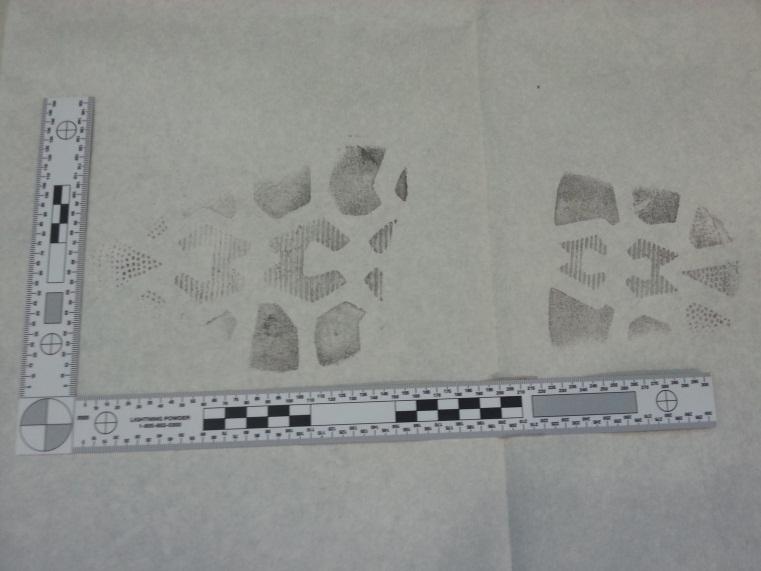
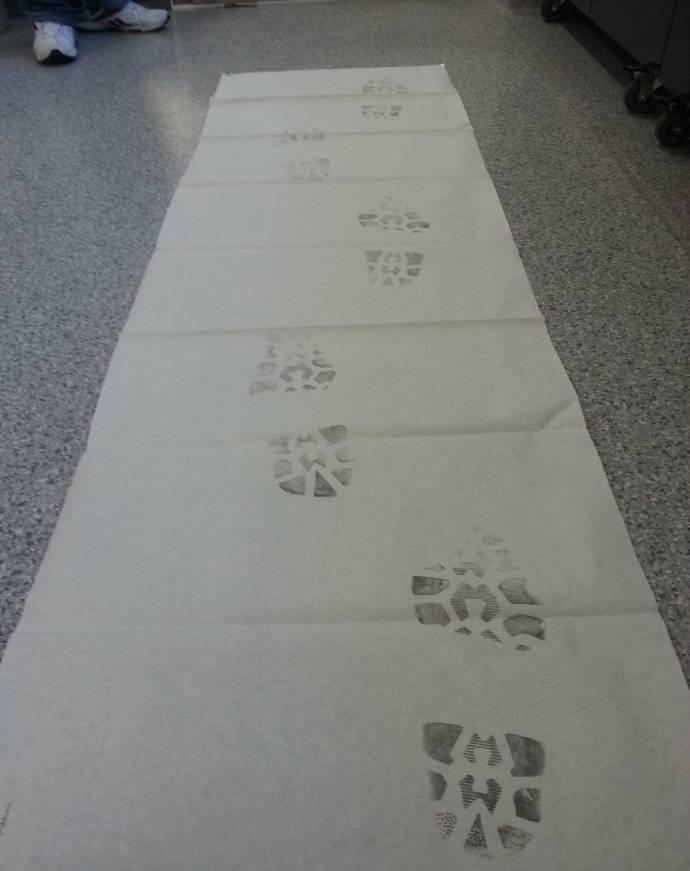
The pictures shown below indicate the shoe prints obtained in a jogging motion.
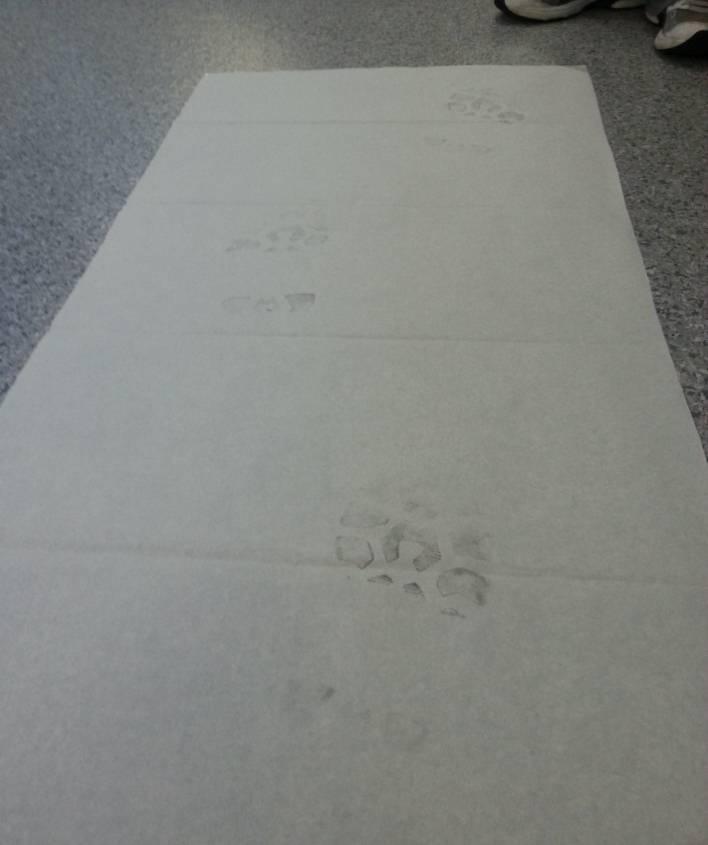
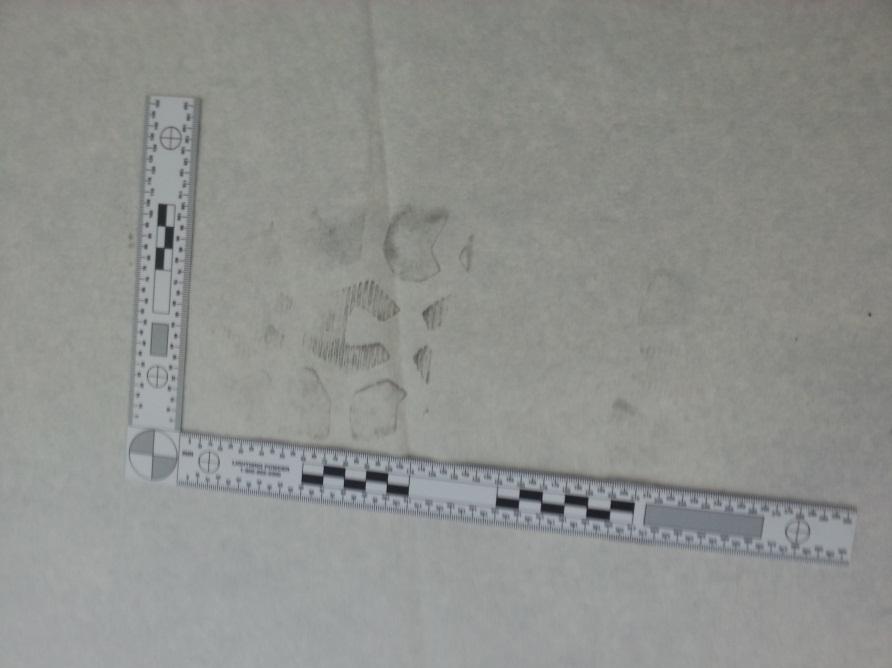
There were obvious differences observed when walking and jogging. The prints obtained when walking were distinct and more pronounced than those obtained when jogging. More than half of the prints appeared lost with each step. The lost prints were partial shoe prints. There was a loss of crucial details when observing partial prints making it difficult to make a comparison to a full print. Different individuals wearing the same shoes elucidated different prints.
Tool Mark Impressions
After mixing the mikrosil casting and using it on the block of wood that contained the five toolmark castings, the results showed that tool B was the contrivance used.
It was possible to link the tools to their corresponding mikrosil casts. That was because the patterns on the mikrosil casting could match a toolmark pattern on the wooden block. There was difficulty in matching up the individual markings and striations observed on the tools. Using a higher resolution microscope to make comparisons could improve the efficacy of this method.
Toolmark Striations
The results obtained after cutting the wires and comparing them under a microscope showed that, each tool mark produced distinctive striations on the object that the implement was used. These results showed that each tool had its outstanding marks or striations.
Real Evidence
Evidence #17 – Cupboard Drawer
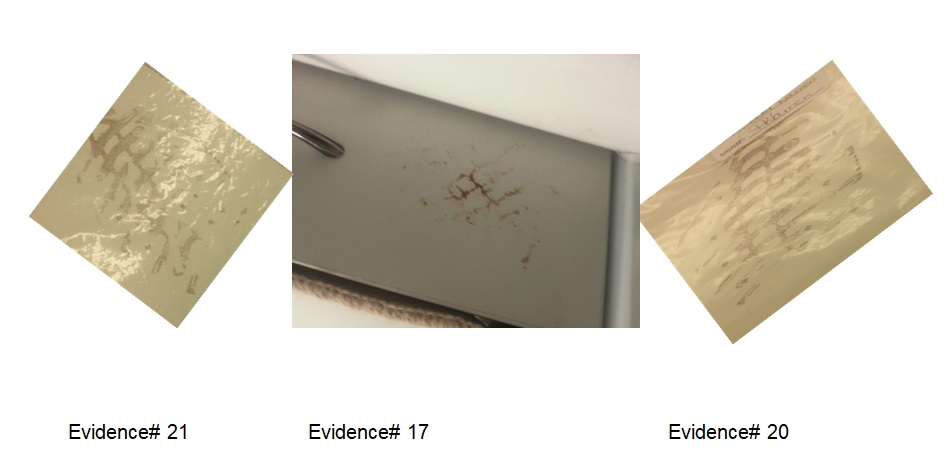
Evidence #18 and #19 – Concrete Casts
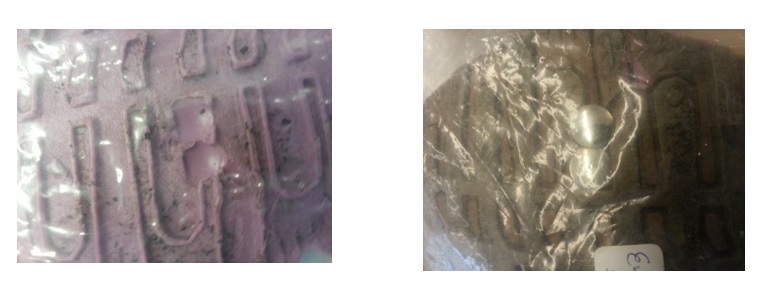
Evidence #20
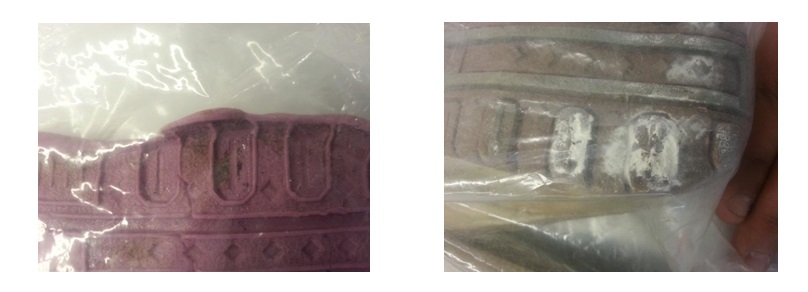
The pictures above showed that evidence 18 shoe cast matched with shoe evidence 20. Evidence 19 shoe cast matched with shoe evidence 21. These outcomes indicated that the two prints were not from the same shoe.
Evidence #23 – Rug
The rug did not have clear footprints for comparison.
Toolmark Evidence
Evidence #17: Cupboard Drawer
Evidence 17 tool impression matched up with evidence 24 tool.
Evidence #27 – Chain with Lock
Evidence 27 chain matched up with evidence 29 cutting tool because they had the same striations.
Blood Spatter Patterns

The tiles 1, 2, and 3 indicated projected blood spatter patterns, with tile 3 showing medium velocity impact spatter. Tile 4 revealed a low velocity impact spatter. Tile 5 suggested passive blood spatter patterns. Tile 6 showed transferred blood pattern. Tile 7 showed an arteriole gushing or spurting pattern whereas tile 8 indicated elongated blood droplets travelling downwards.
Blood Evidence
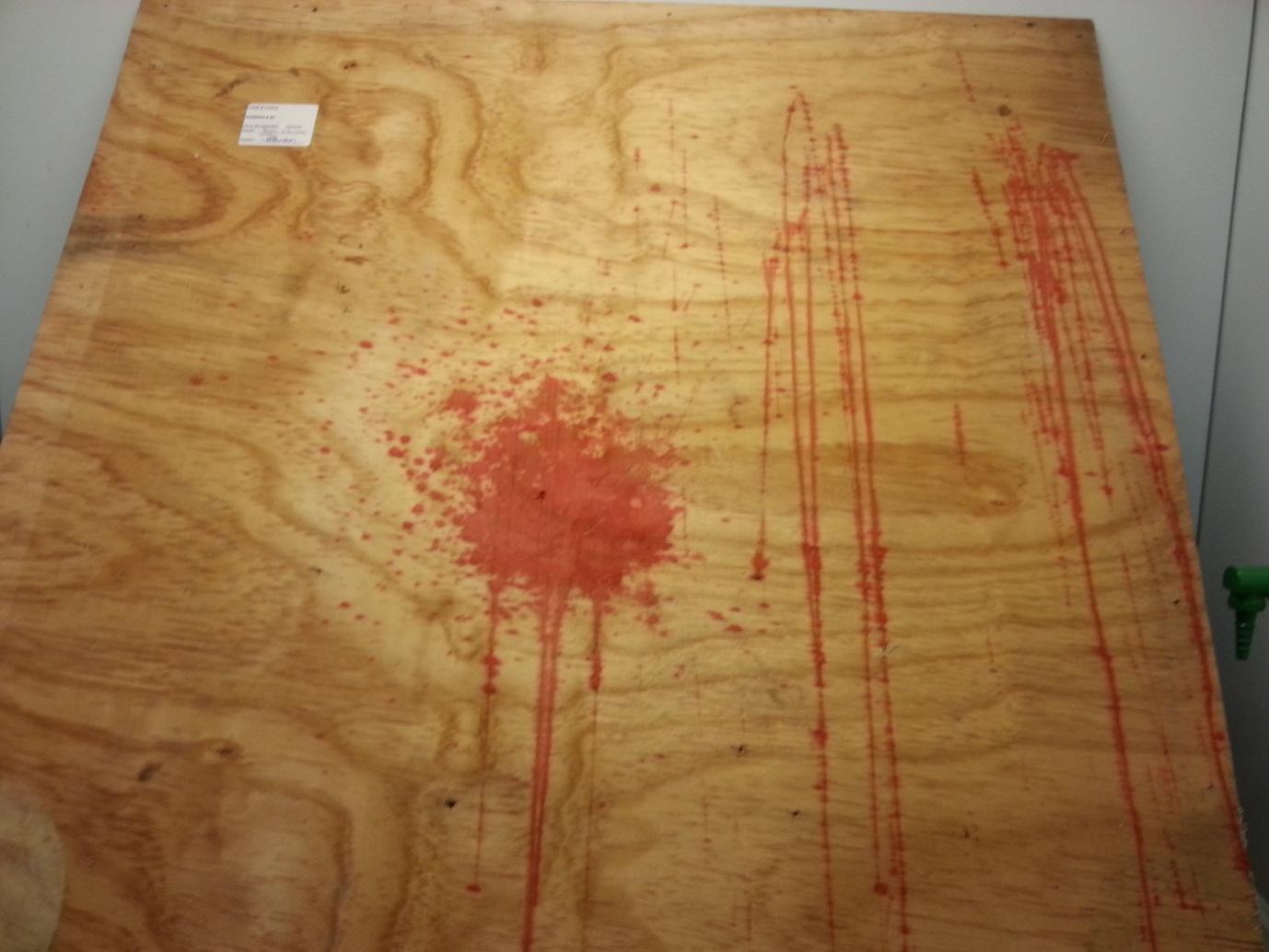
The blood pattern shown on the cardboard was that of expiratory blood. Wind appeared to have blown blood from an open wound on to the cardboard. The picture also displayed a drip pattern. A blunt tool was, therefore, the probable cause of the stain.
Discussion
The shoeprints isolated from the crime scene were compared with the suspects’ shoes previously confiscated as evidence, paying significant detail to the number of matching points. Comparisons in this case were manual through microscopic examination. However, Tilstone et al. (2006, p.260) reveal that expert software could aid in making such comparisons. They further give an example of such software from Britain called Shoeprint Image Capture and Retrieval (SICAR). This system employs numerous databases to look for recognized and unrecognized shoe files for evaluation against shoe samples.
The greasy shoe on the cupboard surface provided the most visible print whereas the cupboard surface had the highest likelihood of obtaining shoe print impressions. Application of grease to a surface increases chances of getting shoeprint impressions on that surface. The clean, dry shoe had the least probability of obtaining prints.
There was a pronounced difference in footprints produced while walking and running. That was because of varying amounts of pressure. During walking, an individual exerted more pressure on the ground. The resultant pressure consequently created highly visible footprints. A running individual exerted less pressure on the ground leading to faint footprints.
The blood evidence pattern together with the footprints and toolmark impressions suggested that the assailant crept towards his victim and inflicted blunt trauma to the victim. An experienced inspector could establish the prospects of what could have transpired at a crime scene using blood pattern evidence (Courtney n.d.).
Conclusions
The results showed that evidence 19 shoe casts matched with evidence 21 shoe. This revealed that the owner of shoe evidence 21 was present at the crime scene. Evidence 18 shoe cast matched with shoe evidence 20. That also meant that the owner of shoe evidence 20 was at the crime scene and that the two owners were prime suspects for the murder. The presence of two different shoe prints from different shoes at the crime scene supports the idea
Tools used in the crime scene were tool 24, tool 29, and tool B.
References
Bell, S, Bell, S, Fisher, A J, B, & Shaler, R, C. 2009, Encyclopedia of forensic science, InfoBase Publishing, New York.
Courtney, M n.d., Blood spatter evidence and reconstruction of events, Web.
Hueske, E, E. 2010, “Firearms and toolmarks”, in A Mozayani & C Noziglia (eds), The forensic laboratory handbook procedures and practice, Springer, New York.
Tilstone, W, Savage, K, A, & Clark, L, A. 2006, Forensic science: An encyclopedia of history, methods, and techniques, ABC-CLIO, California.